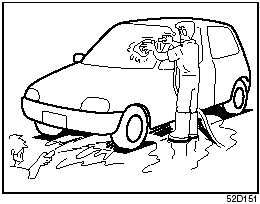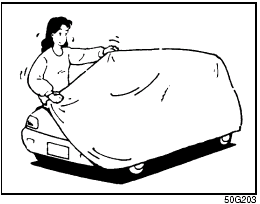 Suzuki Grand Vitara: Corrosion Prevention
Suzuki Grand Vitara: Corrosion Prevention
It is important to take good care of your vehicle to protect it from corrosion. Listed below are instructions for how to maintain your vehicle to prevent corrosion. Please read and follow these instructions carefully.
Important Information About Corrosion
Common causes of corrosion
1) Accumulation of road salt, dirt, moisture or chemicals in hard to reach areas of the vehicle underbody or frame. 2) Chipping, scratches and any damage to treated or painted metal surfaces resulting from minor accidents or impact from stones and gravel.
Environmental conditions which accelerate corrosion
1) Road salt, dust control chemicals, sea air or industrial pollution will all accelerate the corrosion of metal. 2) High humidity will increase the rate of corrosion particularly when the temperature range is just above the freezing point. 3) Moisture in certain areas of a vehicle for an extended period of time may promote corrosion even though other body sections may be completely dry. 4) High temperatures will cause an accelerated rate of corrosion to parts of the vehicle which are not well ventilated to permit quick drying.

This information illustrates the necessity of keeping your vehicle (particularly the underbody) as clean and dry as possible. It is equally important to repair any damage to the paint or protective coatings as soon as possible.
How to Help Prevent Corrosion
Wash your vehicle frequently
The best way to preserve the finish on your vehicle and to help avoid corrosion is to keep it clean with frequent washing. Wash your vehicle at least once during the winter and once immediately after the winter. Keep your vehicle, particularly the underside, as clean and dry as possible.
If you frequently drive on salted roads, your vehicle should be washed at least once a month during the winter. If you live near the ocean, your vehicle should be washed at least once a month throughout the year. Wash your vehicle immediately after using it off-road. For washing instructions, refer to the “Vehicle Cleaning” section.
Remove foreign material deposits
Foreign material such as salts, chemicals, road oil or tar, tree sap, bird droppings and industrial fall-out may damage the finish of your vehicle if it is left on painted surfaces. Remove these types of deposits as quickly as possible. If these deposits are difficult to wash off, an additional cleaner may be required. Be sure that any cleaner you use is not harmful to painted surfaces and is specifically intended for your purposes. Follow the manufacturer’s directions when using these special cleaners.
 WARNING: Foreign material can
lodge between the fuel tank of your vehicle and the skid plate which covers it.
You should periodically clean out any foreign material which has accumulated in
this area, since it could create a fire hazard.
WARNING: Foreign material can
lodge between the fuel tank of your vehicle and the skid plate which covers it.
You should periodically clean out any foreign material which has accumulated in
this area, since it could create a fire hazard.
Repair finish damage
Carefully examine your vehicle for damage to the painted surfaces, especially if it is used off-road. Should you find any chips or scratches in the paint, touch them up immediately to prevent corrosion from starting. If the chips or scratches have gone through to the bare metal, have a qualified body shop make the repair.
Keep passenger and cargo compartments clean
Moisture, dirt or mud can accumulate under the floor mats and may cause corrosion. Occasionally, check under these mats to ensure that this area is clean and dry. More frequent checks are necessary if the vehicle is used off road or in wet weather. Certain cargo such as chemicals, fertilizers, cleaners, salts, etc. are extremely corrosive by nature. These products should be transported in sealed containers. If a spill or leak does occur, clean and dry the area immediately.
Use mud and gravel shields
The use of mud and gravel shields will help protect your vehicle, especially if you frequently drive on gravel or salted roads. Full-size shields, which extend as close to the road as is practical, are the best. The fittings for such shields should also be corrosion resistant. Please check with your authorized SUZUKI dealer for information on these shields.
Store your vehicle in a dry, well-ventilated area
Do not park your vehicle in a damp, poorly ventilated area. If you often wash your vehicle in the garage or if you frequently drive it in when wet, your garage may be damp. The high humidity in the garage may cause or accelerate corrosion. A wet vehicle may corrode even in a heated garage if the ventilation is poor.
 WARNING: Do not apply additional
undercoating or rust preventive coating on or around exhaust system components such
as the catalytic converter, exhaust pipes, etc. A fire could be started if the undercoating
substance becomes overheated.
WARNING: Do not apply additional
undercoating or rust preventive coating on or around exhaust system components such
as the catalytic converter, exhaust pipes, etc. A fire could be started if the undercoating
substance becomes overheated.

Cover your vehicle
If you can not regularly park your vehicle in a garage, we recommend you use a vehicle cover. Years of exposure to midday sun can cause the colors in paint, plastic parts and fabrics to fade. Covering your vehicle with a high-quality, “breathable” vehicle cover can help protect the finish from the harmful UV rays in sunlight, and can reduce the amount of dust and air pollution reaching the surface. Your SUZUKI dealer can help you select the right cover for your vehicle.
 Appearance Care
Appearance Care
...
 Vehicle Cleaning
Vehicle Cleaning
WARNING: When cleaning the interior
or exterior of the vehicle, NEVER USE flammable solvents such lacquer thinners,
gasoline, benzene or cleaning materials such as bleaches and strong household ...
See also:
Lap/Shoulder Belt Untwisting Procedure
Use the following procedure to untwist a twisted lap/
shoulder belt.
1. Position the latch plate as close as possible to the
anchor point.
2. At about 6 to 12 in (15 to 30 cm) above the latch pl ...
Infants And Child Restraints
Safety experts recommend that children ride rearwardfacing
in the vehicle until they are two years old or until
they reach either the height or weight limit of their rear
facing child safety sea ...
Front fog light switch (if equipped)
Front fog light switch (if equipped)
The front fog lights operate only when the
low beam headlights are illuminated.
However, the front fog lights turn off when
the headlights are switched t ...
